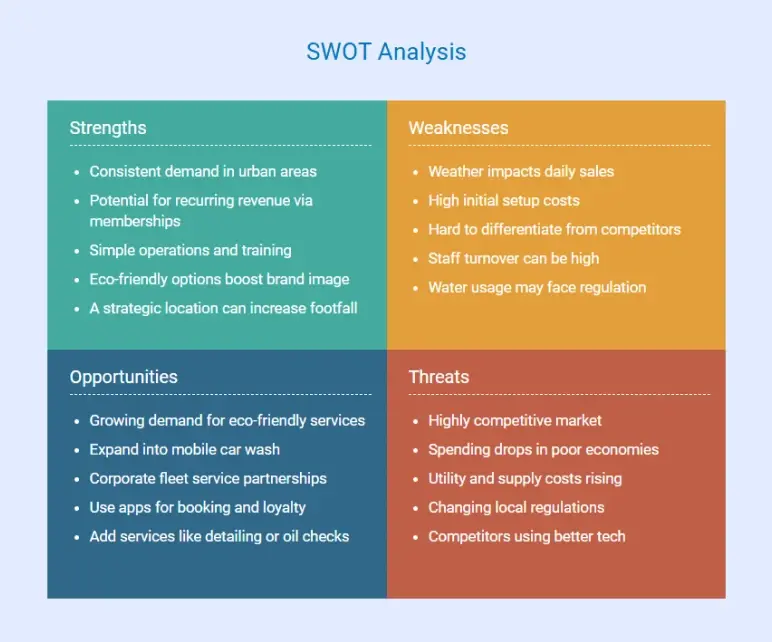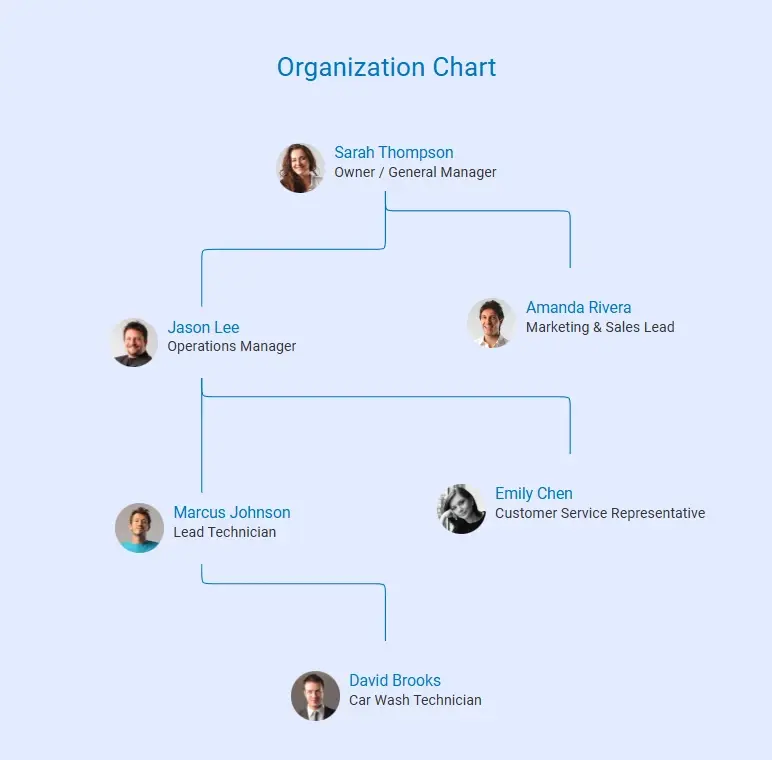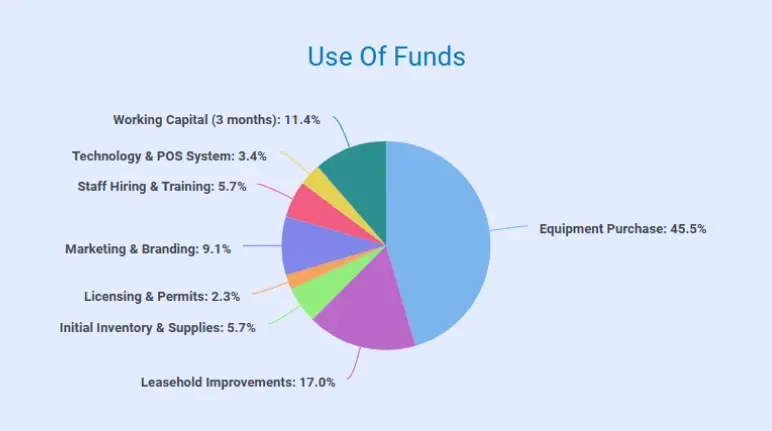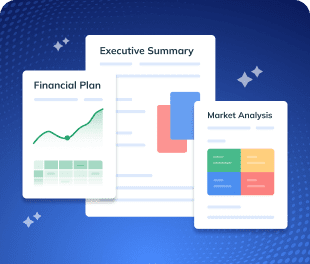Starting a car wash can be exciting and potentially lucrative.
In fact, about 66% of car owners in the U.S. get their vehicles washed 1–2 times per month, averaging 13 washes a year.
That’s a strong, steady demand you could tap into!
However, turning this opportunity into a successful business requires a solid plan. One that helps you map out how to turn your idea into a profitable reality, attract investors, secure loans, and ensure you start on the right foot.
Confused about how to draft a plan?
Worry not! This car wash business plan template is here to help you write a comprehensive plan that will win investors.
Importance of writing a car wash business plan
If you’re serious about starting a car wash, you need a plan. It’s not just for banks or investors—it helps you make smart choices, avoid costly mistakes, and stay on track as your business grows. Further, it helps you:
- Know exactly what you’re building and why
- Set clear goals and action steps
- Understand your startup costs and expected income
- Stay focused and make better day-to-day decisions
- Show lenders or partners that you’re prepared
- Spot challenges early and plan for them
In short, a strong business plan gives you direction, builds trust, and increases your chances of success.
Steps to create an effective car wash business plan
Here are 9 easy steps to guide you through the process of writing an effective business plan. You’ll also learn what to include in each section and how to write it in a clear, concise way.
Let’s dive in!
1. Executive Summary
An executive summary is the first section of your car wash business plan, giving a clear snapshot of your entire plan.
Although it comes first, it’s usually written last, once you have all the details worked out. Why? This will let you summarize the key aspects of your car wash business more effectively.
The goal here is to grab the reader’s attention and give an enticing overview of your car wash business. In a few paragraphs, describe what your business does and why it will succeed.
Start with a compelling introduction to your car wash concept, mentioning the type of car wash you’ll run (e.g., self-service, automatic drive-thru, mobile detailing, etc.) and the core idea or mission behind it.
Here’s a quick list of elements to include in a car wash plan summary:
- Company vision and mission
- Brief business overview
- Market opportunity
- Competitive edge
- Marketing plan highlights
- Financial outlook
- Funding needs (if any)
Think of your executive summary as an elevator pitch in written form. Hence, keep the tone positive and confident. Also, it should be concise. Aim for 1–2 pages or about 2–3 paragraphs.
By the end, the reader should have a clear understanding of your business concept, why it’s promising, and be excited to learn more.
Say goodbye to boring templates
Build your business plan faster and easier with AI
Plans starting from $14/month

2. Business Description
The business description section provides a detailed picture of your car wash business—essentially, who you are and what you do. It covers all the basic facts and background information.
A good approach is to start by stating your business’s name and location and what stage it’s in (startup, expanding, etc.).
Mention the legal structure (i.e., a sole proprietorship, partnership, LLC, or corporation) and ownership—who are the founders or owners of the car wash? If you have a registered business name and any branding in place, include that as well.
This is also a great place to state your mission statement—a memorable one-liner that captures your business’s purpose and values.
Next, outline your business model and clarify the type of car wash as well as the range of services you will (or do) provide. You should even touch on your business goals here, both short-term and long-term.
Moreover, give a brief history or background of how your car wash business came to be. If you’re just starting out, you might share the inspiration behind the idea. If the business is already operating or you’ve made progress, summarize those milestones.
3. Industry and Market Analysis
Now, demonstrate your understanding of the car wash industry and the specific market you plan to serve. Think of it as setting the stage: you’re answering the question, “What environment is my business operating in, and where do we fit?”
A solid market analysis convinces the reader that there is indeed a demand for your services and that you’ve done your homework on the market dynamics.
The following are the key elements to cover in this section:
Industry Overview
Describe the car wash industry at a high level. How big is the industry, and is it growing? Include some data if available.
For example: “The U.S. car wash services industry size was valued at around $14.74 billion in 2024 and is projected to reach nearly $16.95 billion by 2030”.
Also, mention key trends: perhaps more consumers are choosing professional car washes over DIY washing, or maybe there’s a trend toward eco-friendly “green” car wash practices.
Target Market
Next, shed light on your target market—the specific customers you aim to serve. “Who are your ideal customers, and what do they want?” The table below outlines the main customer groups and what they care about most.
| Segment | Description | Needs | Behavior |
|---|---|---|---|
| Everyday Drivers | Commuters, families | Fast service, fair pricing | Visit when car looks dirty, weather-driven |
| Rideshare & Delivery | Uber, Lyft, DoorDash drivers | Frequent washes, subscriptions | Come 2–4 times/week, want speed |
| Small Business Fleets | Vans/trucks for local service companies | Recurring plans, consistent quality | Bulk bookings, value reliability |
| Luxury Car Owners | Expensive or rare vehicles | Hand wash, detailing | Less frequent visits, care about quality |
| Eco-Conscious | Green-minded drivers | Water-saving, non-toxic soaps | Will travel for eco-friendly wash |
Understanding your customers is crucial for shaping everything from your services to your marketing strategy.
Competitive Analysis
Identify and analyze the other car wash businesses you’ll be competing with. List out your direct competitors and briefly discuss their strengths and weaknesses.
What do they do well? What do they do poorly?
This will help you highlight gaps in the market and clearly state your competitive strategy or advantage. Answer the question: “How will our car wash stand out and win customers in this competitive field?”
And yes, including a SWOT analysis in your business plan gives a clear snapshot of your strengths, weaknesses, opportunities, and threats. It helps readers quickly understand your competitive position and shows that you’ve seriously considered both positive and negative scenarios.

Regulatory Compliance
Mention any licenses, permits, or inspections required by your city or state. Show that you understand and plan to follow the laws that apply to your car wash business.
Further, discuss how you’ll handle things like water use, wastewater disposal, chemical handling, and worker safety.
4. Services Offered
In this section, you’ll break down exactly what services your car wash offers. Readers want to know what they’re paying for—and why it’s worth it.
Whether you’re running a basic express wash or a premium full-service operation, list everything clearly and highlight what makes your services stand out.
Start with your core offerings. These are your bread-and-butter services—the ones you expect to deliver most frequently. For instance
- Exterior washes
- Interior cleaning
- Full-service wash
- Self-service bays
If you offer eco-friendly services, be sure to mention them here. Then, move into add-on services and premium packages. These are important because they boost your average ticket size and give customers the flexibility to upgrade their experience.
Here are a few add-ons & premium options you might consider: Waxing and polishing, tire shine, rain repellent treatments, underbody rinse, clay bar treatment, engine bay cleaning, ozone odor removal, etc.
You might also include subscription or membership plans, which are becoming increasingly popular.
5. Marketing and Sales Strategy
This section explains how you’ll actually attract and retain customers. It outlines your strategies and tactics for promotion, advertising, sales, and customer engagement.
Essentially, how will people learn about your car wash, and why will they choose you over others?
Begin this section with specific marketing tactics and channels you’ll use. This is the high-level approach. For instance:
- Branding
- Online presence
- Social media marketing
- Promotions and loyalty programs
- Local partnerships
- Advertising
- Word-of-mouth initiatives
It’s also useful to note sales strategies if applicable. In a car wash, “sales” might not be a traditional sales team, but think about how you’ll increase the average ticket.
Further, make sure your marketing plan also touches on your pricing strategy. Positioning in the market often depends on price too: Are you a premium service with higher prices, or a budget option undercutting competitors?
Overall, the sales and marketing plan should reassure the reader that you have a clear plan to get customers through your doors (or to your website) and keep them coming back.
6. Management Team
Investors and lenders know that a great idea needs a great team to make it happen.
And as the name indicates, the management team section will introduce the people who will be running the car wash and highlight why they’re the right team for the job.
This section can really bolster your plan’s credibility if you can show that you and your team have the skills and experience to execute the plan successfully.
First, list out the founders/owners as well as key team members, along with their titles/roles. Describe their responsibilities, educational backgrounds, and relevant industry experience.
In addition to that, illustrate your organizational chart. It can be helpful to explain how the team is structured and decision-making works. For example:

If you have any advisors or consultants associated with the business, you can mention them here. Though not mandatory, it shows you have professional support where needed.
7. Operations Plan
The operations plan explains the day-to-day workflow and logistics of running your car wash.
This section typically answers: “How will you deliver your service effectively and efficiently?” It covers everything from location and facilities to equipment, processes, and staffing.
A well-thought-out operations plan shows that you have a practical game plan for the actual running of the business, not just the concept.
The following are the key operational aspects to consider when planning this section:
- Location and facility: Detail where your car wash is situated and why that location is advantageous.
- Daily operations: Outline your service process from start to finish. Paint a picture of how a customer goes through your car wash.
- Equipment and technology: List the major equipment, such as automatic car wash systems or pressure washers. Also, mention the technology or software you’ll use.
- Staffing needs: Describe your team structure and staffing plan for daily operations. How many employees will you need, and what will their roles be?
- Supply & inventory management: Note your plan for sourcing supplies, as well as mention how you’ll manage inventory.
Lastly, don’t forget to discuss the maintenance and safety protocols. Investors will want to know you have a plan to maintain equipment. If relevant, mention any safety training or procedures.
8. Financial Plan
The financial plan is one of the most critical parts of your car wash business plan. Here, you’ll translate everything you’ve discussed into numbers, showing what you expect in terms of revenue, expenses, profit, and funding needs.
A solid financial plan demonstrates that you’ve thought through the financial viability of your business.
In fact, potential investors or lenders will often flip straight to this section to see if the business looks profitable and sustainable. A well-prepared financial section signals that your business is serious and committed to its financial goals.
Here’s how to approach this section:
Step 1: Start with your revenue model: Explain how your car wash will make money. Estimate how many customers or sales you expect, perhaps broken down by service type.
Step 2: Then, outline your projected expenses. Car wash expenses include:
- Startup costs (facility renovation, equipment, permits, signage, and so on)
- Fixed ongoing costs (such as rent or mortgage, utilities, insurance, and salaries)
- Variable costs (like water usage, electricity, cleaning supplies, and maintenance)
- Other expenses (marketing budget, accounting services, etc.)
Step 3: Include the core financial statements, like revenue forecast (sales projections), profit & loss statement (income statement), cash flow statement, balance sheet, and break-even analysis.
Moreover, it’s wise to list the key assumptions you made in your projections. Laying these out helps readers understand how you arrived at your numbers and assess if they are realistic.
You might even mention a contingency plan, like the best and worst-case scenarios. If you’re seeking financing, clearly state how much funding you need and for what. Something like this:
| Category | Estimated Amount (USD) | Description |
|---|---|---|
| Equipment Purchase | $40,000 | Car wash machinery, vacuum units, water recycling system |
| Leasehold Improvements | $15,000 | Plumbing, construction, electrical, signage |
| Initial Inventory & Supplies | $5,000 | Soaps, wax, towels, and detailing supplies |
| Licensing & Permits | $2,000 | Local business and environmental permits |
| Marketing & Branding | $8,000 | Website, digital ads, grand opening campaigns |
| Staff Hiring & Training | $5,000 | Recruitment, uniforms, onboarding, and skill training |
| Technology & POS System | $3,000 | Booking system, POS, customer loyalty software |
| Working Capital (3 months) | $10,000 | Payroll, utilities, and buffer for early operations |
| Total | $88,000 |

Remember, a thorough financial plan builds confidence that you understand the monetary side of running a car wash.
If finance isn’t your strong suit, consider using financial forecasting software to ease your process, or read up on how to write the financial section of a business plan for more detailed guidance.
9. Appendix
The appendix is the final section of your car wash business plan. Think of it as a repository for any detailed information or documents that support your plan but are too bulky to include in the main sections.
This keeps the main body of your plan focused and concise, while still providing all the evidence and backup a serious reader might want to see.
Not every business plan needs a lengthy appendix, but including one can add credibility and thoroughness to your plan.
Here are some items you might include in your appendix for a car wash business plan:
- Market research data
- Location and lease documents
- Brochures or specifications for major equipment
- Detailed financial statements or projections
- Resumes of key team members
- Legal documents, licenses, or insurance policies
- Marketing materials
Keep the business plan appendix organized. It provides that extra assurance and detail for those who want to delve deeper into your business proposal.
Download a free car wash business plan sample PDF
Writing a car wash business plan from scratch can be challenging, especially if it’s your first time. To make things easier, you can use our free car wash business plan template (PDF) as a starting point.
This template comes with pre-filled prompts and examples for a car wash business. You can even replace the sample content with your own business details to save you a lot of time and ensure you don’t miss any important sections.
The Quickest Way to turn a Business Idea into a Business Plan
Fill-in-the-blanks and automatic financials make it easy.
Conclusion
Summing up! We’ve covered everything from introducing your business idea, analyzing the market and customers, plotting out your operations, to crunching the financial numbers.
Now, you should have a clear understanding of how to write each part of your car wash business plan.
However, if you’re still feeling confused or looking for an easy way to write a full plan, Upmetrics is here to help! It’s a modern AI-powered business plan software that involves an interactive business plan builder, and AI writing/forecasting assistance, as well as hundreds of business resources to simplify the process.
Also, it guides you through each section or even generates business plan drafts that meet the expectations of banks or investors.
So, don’t wait any longer; start putting your plan together!



